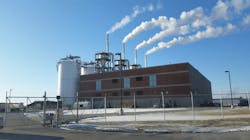Implementing a computerized maintenance management system (CMMS) at a single plant without encountering any snags is rare. Standardizing operations and rolling out a CMMS at multiple plants has, not surprisingly, many more challenges. Technical issues, new leadership, lack of training, and overall resistance to change represent just some of the obstacles an organization might encounter.
Sometimes, taking a step back and examining what is working and what is not can put things back on track. That is what the New England Fertilizer Company (NEFCO), a biosolids management industry leader, did to increase the chances of achieving its corporate and continuous improvement goals.
The Michigan-based Great Lakes Water Authority (GLWA) provides water and wastewater services to Detroit and the surrounding communities. In 2013, the organization chose NEFCO to design, build, operate, and maintain its new biosolids dryer facility. In conjunction with the new facility, the two companies agreed to implement a state-of-the-practice CMMS system.
The company also wanted to extend the CMMS to four other plants, including Cumberland, Md.; Shakopee, Minn.; Quincy, Mass., and West Palm Beach, Fla., and leverage the system to standardize maintenance and operations system-wide.
Before the CMMS implementation, each NEFCO plant ran autonomously and had previously utilized a variety of outdated maintenance management systems. Standardizing operations at multiple plants that can interface with different client systems requires someone who can communicate the need for change deftly and unify individuals for a common purpose — continuous improvement. Bill Hollman, NEFCO’s corporate operations and safety manager, oversaw the CMMS implementation and ultimately transitioned five facilities to the eMaint system.
For a CMMS multi-site implementation to succeed, many issues must be addressed. Each has the potential to derail the effort before, during, or after completion, making them critical to the program’s success. The process should include:
- CMMS buy-in across all sites
- Pre-planning and goal setting
- Strict adherence to standardized workflow processes once in place
- Accurate and consistent data entry
“We had meetings, and all plants were invited to participate and have skin in the game if you will, to discuss continuous improvement,” Hollman explained. “The plants all had their own data, and so each had their own baselines based on what they had collected with the system.”
Access for Success
Following implementation, NEFCO’s plants used the CMMS with varying degrees of adoption rates and functionality. Unfortunately, support for standardization was limited. Some plants stuck to the new optimized workflow processes, while others either adopted them in part or not at all.
NEFCO recognized that although the CMMS objectives were potentially more effective than those of the legacy systems, they were not fully embraced. So, in 2018, the organization decided to participate in a continuous improvement assessment provided by the CMMS vendor. The assessment would act as a tool to identify the next steps for NEFCO to redeploy its CMMS and level set achievable, measurable goals in line with the organization’s overall objectives.
Additionally, both Hollman and Manuel Irujo, NEFCO’s vice president of operations, attended Certified Reliability Leader (CRL) classes and received their certifications as CRLs. Almost immediately, the organization began putting the asset management and maintenance reliability leadership tools into action.
With the assessment in hand, NEFCO had a clearer understanding of where the business stood and where it needed to go. Key stakeholders, including plant managers, chief mechanics, administrators, and Hollman attended an intensive two-day CMMS training boot camp to learn how to leverage the system thoroughly to ensure continuous improvement.
Maximizing the CMMS
After the assessment, boot camp attendees and other essential stakeholders met regularly to ensure plants were adhering to their realigned standardized maintenance processes and best practices. Hollman deployed enterprise-level key performance indicators (KPIs) to track and measure organizational success relative to NEFCO’s realizable goals and objectives.
“Because all the work orders, project formats, and KPIs are the same, I’m able to roll those up,” Hollman said. “And with our consolidated account, I can easily generate reports so we can look at NEFCO on a corporate-wide basis and use them to compare plant to plant.”
The organization noted that some plants had superior insight, while others did a better job with overall corporate tracking. The ability to compare each plant’s CMMS usage helped the company pinpoint opportunities and areas needing improvement.
“We discuss the data and ask, ‘Hey, what’s going on in this plant? Why is this like this? Are they doing things better? What things can we share?’” Hollman said. “So just by being on a like system, drawing from the same kind of database has allowed us to be much more efficient in the way we do things on a corporate level.”
Simple, Painless Compliance Audits
NEFCO is audited regularly, and Hollman and the plant managers appreciate the ability to quickly pull up asset maintenance records and reports stored in the CMMS. Hollman recounted a time when an auditor summarily asked him for the West Palm Beach maintenance records. He astonished the auditor by almost immediately providing thorough, clear reports demonstrating compliance.
“Within five minutes, I had our office manager get the data from the CMMS and come in with a [flash drive] with everything we’d done in the previous 12 months,” Hollman says. “The auditor could see every time we turned a wrench, every PM, every corrective, the asset health, and spare parts inventory.”
Safety Program Incorporation
NEFCO also uses the system to track and manage its safety hazard identification program, Eye on Safety. The plants share any safety hazards they discover and how each plant identifies and corrects the issue. Before implementing the program, safety audits were time-consuming because there were no uniform processes and safety corrections were documented on paper. Hollman incorporated the Eye on Safety program into the CMMS, which enabled all of the plants to share safety information quickly.
“We jointly developed, and then my team built dashboards, tables, pie charts, workflows, and everything else,” Hollman noted. “All the plants have access. Our corporate vice president of safety and I conduct internal safety audits. Any items we find can be rectified and then shared throughout the company.”
Not surprisingly, since introducing the program, NEFCO has decreased hours in lost time and OSHA recordables.
“More importantly, it’s not just metrics; It’s that people aren’t at risk of getting hurt as much,” Hollman said.
With the Eye on Safety blueprint established, the company can quickly implement the program at any new facility.
For the Record
NEFCO achieved plant-wide asset management and maintenance standardization with the help of the CMMS. Hollman attributes the success of the reboot to participation in the assessment, and the expert and continuous vendor support. NEFCO’s plants are now maximizing the CMMS to keep assets up and running and, in turn, keeping the environment clean.
“If the assets are working properly, then we don’t have emissions, we don’t have odors, system spills, or violations, and that’s all based on keeping the equipment running properly and proper asset management,” Hollman said. “Having that record is very important.”
Most recently, Hollman earned the Uptime Elements Certified Reliability Leader Black Belt, the organization’s highest level. The program acknowledges significant and successful holistic reliability improvement projects delivered consistently. WW
About the Author: Gregory Perry, CMRP, CRL, is a Certified Reliability Leader with nearly two decades of experience in maintenance and operational best practices. He is dedicated to positive client relationships and brings a broad base of knowledge to the table in the areas of MRO and storerooms, world-class maintenance principles, and world-class CMMS consultation and leadership. He is a senior maintenance reliability consultant with Fluke Reliability. In addition to delivering implementation and consultative services to clients, Perry also presents maintenance best practice sessions at leading industry conferences and has authored several online best practice webinars.
About the Author
Gregory Perry
Gregory Perry, CMRP, CRL, is a Certified Reliability Leader with nearly two decades of experience in maintenance and operational best practices. He is dedicated to positive client relationships and brings a broad base of knowledge to the table in the areas of MRO and storerooms, world-class maintenance principles, and world-class CMMS consultation and leadership. He is a senior maintenance reliability consultant with Fluke Reliability. In addition to delivering implementation and consultative services to clients, Perry also presents maintenance best practice sessions at leading industry conferences and has authored several online best practice webinars.

